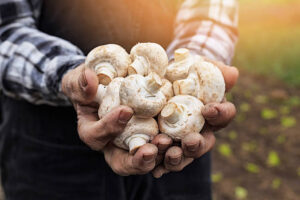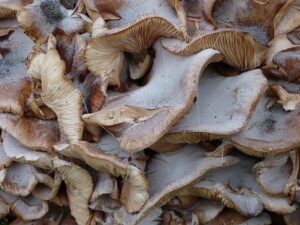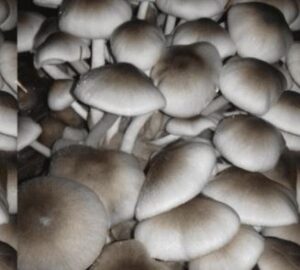Indian Mushroom: Growing mushrooms is essentially a business. The mushroom industry is one of the most profitable and productive businesses in India today. Farmers’ hard work gets converted into profit in a short time, so it’s gaining popularity in India. The cultivation of mushrooms is an alternative source of income for farmers in India. It is tasty to eat mushrooms. You can stir it into soups, vegetables, stews, or top it on pizzas.
Uttar Pradesh, Kerala, and Tripura are the most important mushroom producing states in India. Besides being delicious, mushrooms contain a variety of nutrients that promote health, including proteins, fibers, potassium, copper, zinc, selenium, magnesium, and nutrients that fight cancer.
Is it possible to start mushroom farming in India? It is easiest to cultivate mushrooms. There are more profits to be made in mushroom farming with less investment. Mushroom harvesting in India is the most popular topic here. You will find comprehensive information about mushrooms on this blog. We’ll get right into it.
Read More: The different types of agricultural robots and their importance
Indian Mushroom Cultivation Types

The three main types of mushrooms harvested are button mushrooms, oyster mushrooms, and paddy straw mushrooms. Mushrooms grow in different styles and techniques using unique methods and techniques. Composted beds are used to grow mushrooms.
What is the best way to grow mushrooms? That’s why you’re here. Growing mushrooms is easy. Since mushroom cultivation in India is so cheap, it is the best way to earn profits. The stages of mushroom growth are shown here in detail. We’ll tell you everything you need to know about it, so that you can produce mushrooms and increase your income.
What is the best way to harvest mushrooms in India?
The most profitable business idea at present is mushroom harvesting. There is a rapid spread of this practice throughout India. This is primarily among the new generation of farmers who want to earn more profit in a shorter period of time. The following steps will show you how to harvest mushrooms in India. You can see it below.
1. The button mushroom

The following steps will guide you through the process of growing button mushrooms. Here’s what we found.
The Making of Compost
Growing button mushrooms begins with composting. Open air is used for this process. Concrete platforms are used to grow button mushrooms. Two types of compost are prepared, as follows
(a). Natural compost
Compost that comes from nature is called natural compost. Compost for button mushrooms is made with wheat straw, horse dunk, gypsum, and poultry manure, among others. Spread all the elements on the compost yard and blend them well. Wet the prepared compost with water after this.
(b). Synthetic Compost
To produce synthetic compost, urea, gypsum, bran, wheat straw, and ammonium nitrate/ammonium sulphate were needed. Firstly, cut the straw about 8-20 cm long. Spray water over the compost after spreading an equally fine layer of cut straws. Using calcium nitrate, urea, gypsum, and bran, mix them together well.
- Compost should be filled in the tray
As compost was being prepared, it turned dark brown in color. We should not spread compost on trays that are too wet or dry at times. Spread water on dry compost if it’s dry. Soft wood should be used for the compost tray, and it is best to use one that is 15 to 18 cm deep. Alternatively, you can adjust the tray according to your comfort.
- The spawning
In order to grow button mushrooms, the next step is to spawn them. Mycelium is sown into the beds during this process. A tray bed can be spawned in two ways: the first is with compost, and the second is with mycelium blended with compost. After sprinkling water and spawning, cover the tray with newspaper to maintain moisture.
- The casing
The tray needs to be covered with a thick layer of soil now. Blend garden soil with rotten cow dung to make this soil. Casing soil is what this soil is called. Water is well absorbed by this casing soil.
- Mushroom harvesting
Harvesting button mushrooms is the next step in the farming process. In 15 to 20 days after casing, mushrooms’ pinheads appear. The next step is to twist the head gently from the soil, holding it firmly.
Last but not least, mushrooms should not be kept in the refrigerator for longer than 3 to 4 days. Make mushrooms last longer by covering them with a moist towel.
Read More: Techniques and solutions for smart farming in India
2. Mushroom oyster

It is one of the simplest mushrooms to produce, and it is very tasty to eat. A mushroom of this type does not require any special conditions, unlike a mushroom of the same type. Oyster mushrooms are also low in fat, which is why doctors recommend oyster mushrooms to patients with diabetes or high blood pressure.
The following video shows how oyster mushrooms are grown in India. Let’s take a look.
- Substrate processing
The production of oyster mushrooms requires less effort than that of button mushrooms. The waste from banana trees, paper, cotton, and paper can be used to grow oyster mushrooms. The oyster mushroom can be grown in rectangular blocks or polythene bags.
(a). Blocks of rectangles
Using a polythene sheet, lay down a thin bed of paddy straw on a rectangular block of the wooden frame without a base. Make sure it’s wet. Spread spawns over it and cover it with another thin sheet of paddy straw. Apply a layer of paddy straw on top of the same process three to four times.
(b). The polythene bag
The next step is to cut paddy straws into tiny pieces and wet them with water properly. A polythene bag with small holes for air circulation will be used to collect the straw after the excess water separates. Last but not least, blend paddy straw and spawn in a ratio of 0.2:6.
The process of spawning
After 10 to 12 days, small buds appear and the straw gets locked in. Taking off the polythene and placing on shelves is the best time to do so. Water it twice a day.
For harvesting and storing oyster mushrooms, the same procedure will be followed as for button mushrooms.
Read More: Without farmers, what kind of problems would arise?
3. Paddy Straw Mushrooms

Mushrooms consumed worldwide are most commonly paddy straw mushrooms. Southeast Asia is the most prominent region for its cultivation. Paddy straw mushrooms are the most profitable of all the types, and they require the least amount of investment. A straw mushroom is a mushroom that grows on paddy straw. The cultivation procedure for paddy straw mushrooms can be found below.
- The spawning process
Growing mushrooms requires soaking paddy straws. Straw spawns are when they have fully spawned.
- The bedding
It is now necessary to prepare a strong foundation with bricks and soil that will hold all the weight of the structure. Spread spawn on the edges of eight straw bundles, four on each side. Continue to repeat these steps.
- Taking mushrooms
It takes about 15 to 16 days for mushrooms to appear. The mushrooms should be stored in the same manner as before.
How much does mushroom farming in India cost?
There is a rapid increase in market value, demand and benefits for mushroom products in the Indian mushroom industry today. Many people wonder how much it costs to grow mushrooms. The following is a rough estimate of the answer to this question.
It costs about Rs. 1,50,000 to cultivate mushrooms in India. It includes scrap wooden shelves (Rs. 20,000), construction costs (Rs. 1,25,000), and other miscellaneous costs (Rs. 5000).
Training in mushroom farming in India

The Indian government is currently focusing on Indian agriculture and training farmers for more efficient and effective productivity. The best way to learn mushroom cultivation is to join the government’s mushroom cultivation training program. It is now possible to take mushroom cultivation training online, which is the easiest way to learn.
There are several types of mushrooms that are grown in India and these are all related to mushroom farming. Last but not least, we show where you can obtain mushroom farming training. The information I provided about mushroom farming in India should have been helpful to you. With this app, you can grow mushrooms easily and gain a lot of profit. Keep up with Aarug Agro to learn more.
Read More: Utilizing agricultural products for business purposes


